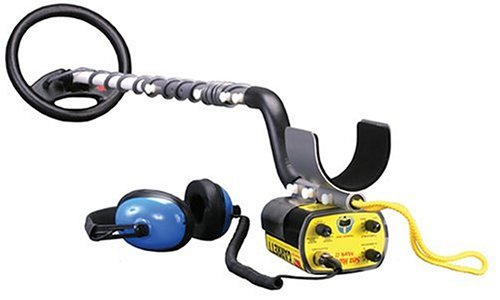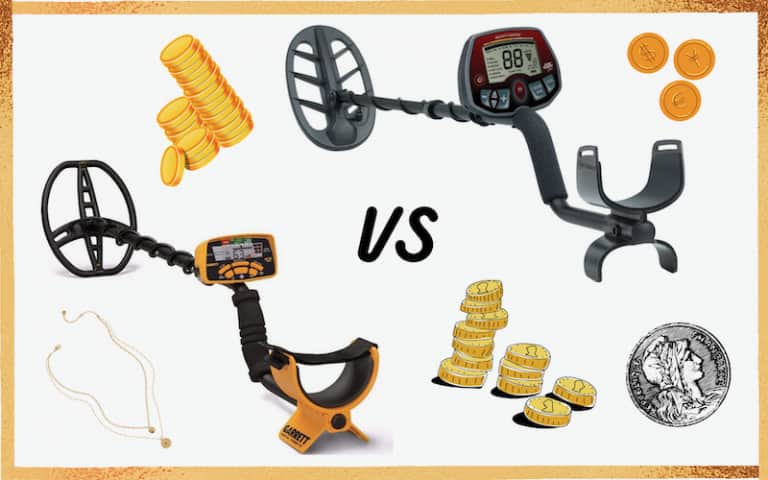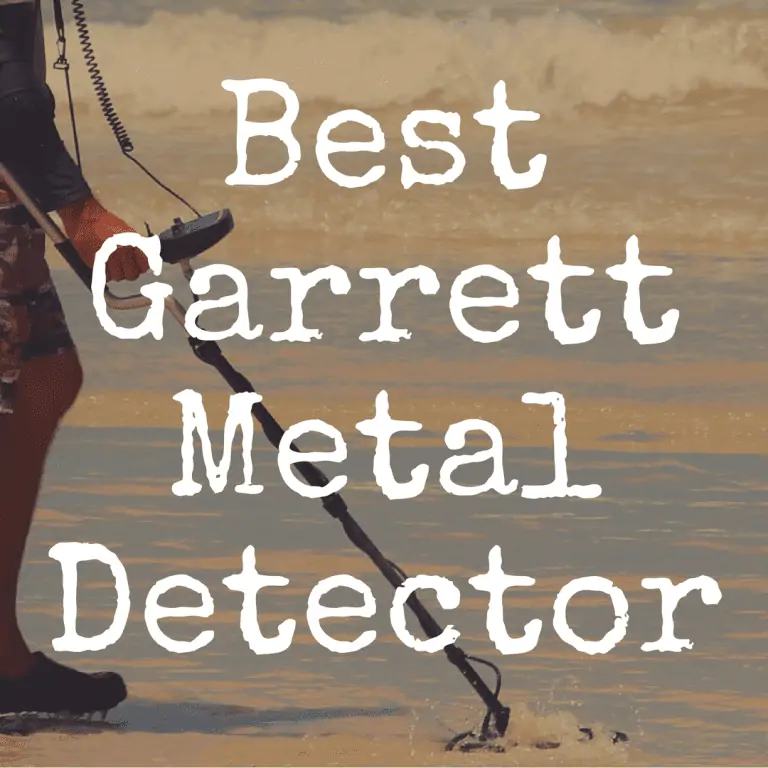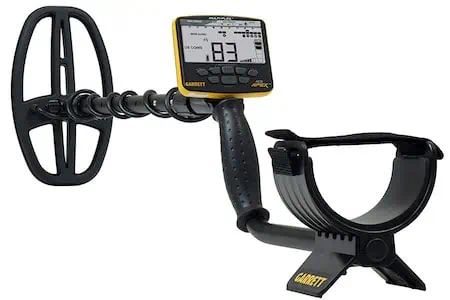Garrett Ace 400 vs Garrett AT Pro
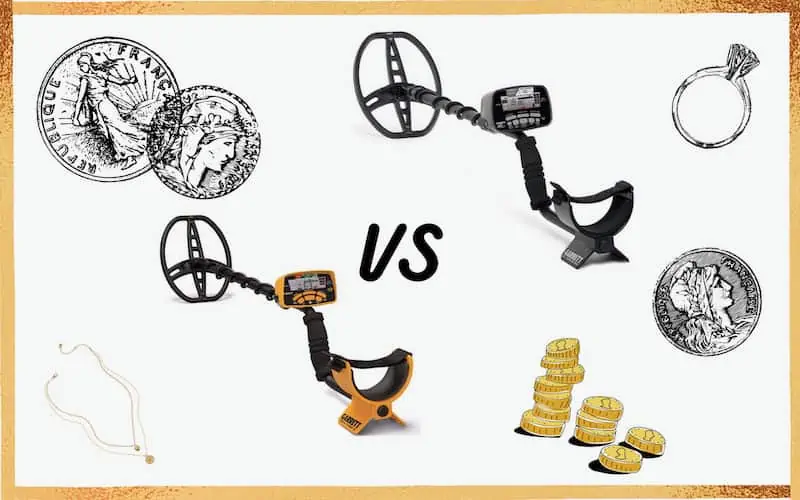
Buying a metal detector can be confusing. There are so many manufacturers and models on the market it can be difficult to narrow down which one is right for you. Garrett is one of the oldest manufacturer of metal detectors and continues to be an industry leader.
They make many models that are tailored to all experience levels. They recently acquired the White’s brand of metal detectors and are rebranding them under the Garrett label. In this article, we will discuss 2 models of Garrett metal detectors, compare them, and decide which one is the best. This is the battle of the Garrett Ace 400 vs Garrett AT Pro.
| Photo | Model | Price | Features |
|---|---|---|---|
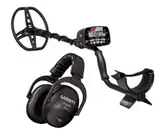 | Garrett AT Max | $$$ | Waterproof to 10 feet |
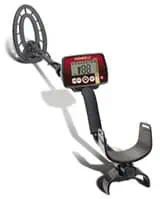 | Fisher F22 | $$ | 9″ Triangulated Concentric Coil |
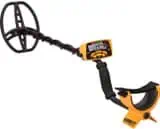 | Garrett Ace 400 | $$$ | 8.5 x 11" DD coil |
 | Minelab Vanquish 540 | $ | Search Modes: Coin, Relic, Jewelry, Custom, All Metal |
Garrett Ace 400
The Garrett Ace 400 is the highest model in their traditional Ace lineup of metal detectors. The Ace 400 is a single frequency metal detector operating at an adjustable frequency of 10 kHz. That may sound confusing: a single frequency detector that is adjustable. All this means is the frequency can be shifted slightly up or down to help compensate for electromagnetic interference or elevated levels of soil mineralization.
The Ace 400 is an all-around metal detector, meaning it is not tailored to a single type of metal. It will struggle to find small or fine gold because of the operating frequency. Frequencies above 18 kHz are the best for finding small gold. The Ace 400 will still find gold, but it will struggle for prospecting if there is mostly small or fine gold.

The Ace 400 has a small LCD screen with numerical target identification. It has iron audio so users can hear iron targets and decide whether to dig them or leave them. It also features adjustable notch discrimination. This is helpful because you can decide which metals to search for and which metals to exclude from detection.
The Ace 400 has 8 levels of adjustable sensitivity and 8 levels of depth adjustments. The LCD screen also features a graph above the numerical target identification showing the likely type of metal found. Buttons listed under the screen allow users to change the search mode, adjust discrimination and sensitivity, adjust the iron audio, frequency, and activate and use the built-in pinpoint mode.
One drawback of the Ace 400 is it comes with factory pre-set ground balancing. This can be an issue in areas with high soil mineralization, saltwater, hot rocks, and black sands. The Ace 400 has 5 search modes:
- Zero Disc – The Ace 400’s all metal mode. Detects all metal types with no discrimination.
- Jewelry – Filters out most iron trash while targeting the most common jewelry metals.
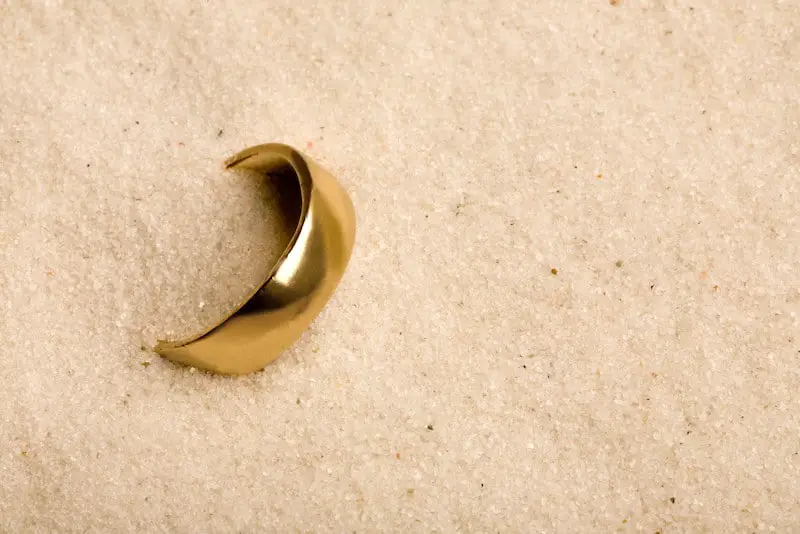
- Relics – This mode eliminates small iron items while finding lower conductivity targets like lead, bronze, and brass.
- Coins – Coin mode eliminates pull tabs, foil, and other commonly found trash items.

- Custom – Custom mode lets users customize their notch discrimination patterns. You choose what to accept or reject to customize what you want to detect. These settings will save after the detector is powered off so you can keep using your custom mode.
Garrett’s Ace 400 comes standard with an 8.5” by 11” Double-D PROformance search coil. This search coil is waterproof, but the Ace 400’s control box is not. This means it should not be fully submerged in water but can be used with caution around shallow waters. The Ace 400 uses 4 AA batteries and is lightweight, at just under 3 pounds. The Ace 400 can easily find a target up to 8” deep in good soil conditions.
This model will struggle in areas with saltwater because of salt’s natural conductivity. It is not intended for use on saltwater beaches but will do very well in freshwater areas. This is a common thing for single frequency metal detectors. The Ace 400’s lack of adjustable ground balancing also affects its performance in saltwater and areas with high soil mineralization.
These features make the Ace 400 a great contender in the battle of Garrett Ace 400 vs Garrett AT Pro!
Garrett AT Pro
The Garrett AT Pro is one of the best-selling models of Garrett metal detector. It has been on the market for over 10 years and continues to sell very well. The AT Pro is an all-terrain metal detector. This model is fully waterproof up to 10 feet. This opens a new world of metal detecting as you can now take it on shallow dives in rivers, lakes, streams, and beaches.

The AT Pro features Pro Audio, or Proportional Audio, which lets users hear discriminated iron so you can decide if you want to dig the target or leave it. To use the Pro Iron Audio feature, some level of discrimination is required. Pro Iron Audio does not work in all metal modes because all metals, including iron, will give an audible signal.
The AT Pro’s 3 Pro Audio allows users to hear very subtle changes in target response. This helps users better estimate a target’s size, depth, and shape. This makes recovery time quicker and helps differentiate when targets are close to one another. It also has 3 standard audio modes that give full-strength audio signal regardless of the target amplitude. The binary audio system is preferred by some detectorists for its simplicity. The volume of this model is not adjustable.
The AT Pro has 40 adjustable levels of iron discrimination. This allows finer resolution to separate targets from trash. It has Fast Track ground balancing and manual ground balancing. This is extremely helpful in areas with high soil mineralization, hot rocks, and black sands. The AT Pro features 8 levels of sensitivity adjustments and 8 levels of depth adjustments. The LCD screen features digital target identification, a pinpoint mode, and 3 audio tone identification levels.
Garrett’s AT Pro is a single frequency metal detector that operates at an adjustable 15 kHz. As with the Ace 400, this means the frequency can be shifted slightly up or down to compensate for electromagnetic interference and soil mineralization. The AT Pro will do well finding all metal types, but still struggle to find fine and small gold. Again, 18 kHz and above is the best for gold prospecting. The AT Pro comes standard with an 8.5” by 11” Double-D search coil. This model is lightweight, at just over 3 pounds, and operates on 4 AA batteries.
Garrett Ace 400 vs Garrett AT Pro
Both the Ace 400 and AT Pro are lightweight, come standard with the 8.5” by 11” search coil, and use 4 AA batteries. Both are single frequency, but the AT Pro operates at a higher frequency of 15 kHz, compared to the 10 kHz of the Ace 400. Neither will do very well in areas with saltwater because of the high conductivity of salt.
The AT Pro features both manual and automatic ground balancing. The Ace 400 comes with factory pre-set ground balancing. This is an especially important distinction. If you live in an area with high soil mineralization, ground balancing is necessary. Most factory pre-set ground balancing is for good to moderate soils.
This means these detectors will struggle in areas with high soil mineralization. Where I live, we have a large amount of soil mineralization. Most single frequency detectors without ground balancing do not work well here. They give constant false readings, excess ground noise, and overload the machine. This means the AT Pro will work much better in these areas than the AT Pro.
Another difference between the 2 metal detectors is their waterproofing. The AT Pro is fully waterproof up to 10 feet. This allows users to detect in shallow waters safely. The Ace 400 is only water resistant, so the control box cannot be fully submerged in water, or it will ruin the detector. The AT Pro also features Proportional Audio, which can detect small audible changes in target response. The AT Pro has 6 search modes because the Pro Audio gives 3 additional search modes.
The Ace 400 has more preset search modes than the AT Pro, but the AT Pro uses customizable modes in Pro Audio so you can discriminate the metals you want to find or hide. Neither the Ace 400 nor AT Pro will be the best detector for gold prospecting. They do not run on a high enough frequency for finding small gold nuggets or fine gold jewelry. Both will have no problem fining larger pieces of gold or larger gold jewelry or oversized coins.

Conclusion
Now that we have discussed each metal detector in depth, which one wins in Garrett Ace 400 vs Garrett AT Pro? While both metal detectors are great options and are perfect for all skill level detectorists, I would recommend the Garrett AT Pro over the Ace 400.
The AT Pro features adjustable ground balancing, which I can say from experience is necessary when detecting in anything but good soil conditions. The AT Pro is also fully waterproof up to 10 feet, so you do not have to worry when detecting in shallow rivers, streams, lakes, or beaches.
The AT Pro also features Proportional Audio, which some users prefer to the traditional binary audio. But if you do prefer binary audio to Proportional, you can use one of the 3 search modes that use binary audio on the AT Pro. Proportional Audio allows you to better hear minute changes in target response.
This type of audio response is great for areas with high trash. These Pro Audio modes are great when searching for relics or for coin shooting. Relics are often found in areas with high trash simply because they are areas where human activity has taken place. Pro Audio can help you better hear the difference between the trash and the treasures.
The AT Pro also operates on a higher frequency than the Ace 400. 15 kHz is at the top end of the best range for general metal detecting. However, the higher the frequency the better it can detect lower conductivity metals. The AT Pro is more expensive than the Ace 400, so if your budget does not allow, do not fret! The Ace 400 is still a fantastic metal detector.
This detector is more catered to beginning and intermediate metal detectorists, so if you are not looking to spend a whole lot on a good detector, the Ace 400 will work very well.
One final note, when metal detecting, remember, you are an ambassador for the entire metal detecting community. Be kind and courteous, clean up any trash you find, fill in any holes you dig, be mindful of other people, and leave an area better than you found it.
Also, remember to never trespass, never disturb wildlife or historical buildings or sites, and try to minimize your environmental disturbance. If we want to ensure we can continue to metal detect, we all must band together to follow these etiquette rules for metal detecting. It only takes a handful of complaints from disgruntled citizens for us to be restricted even further.
FAQ
If you enjoyed this article, please “like” our Facebook page!
You Might Also Want to Read:


